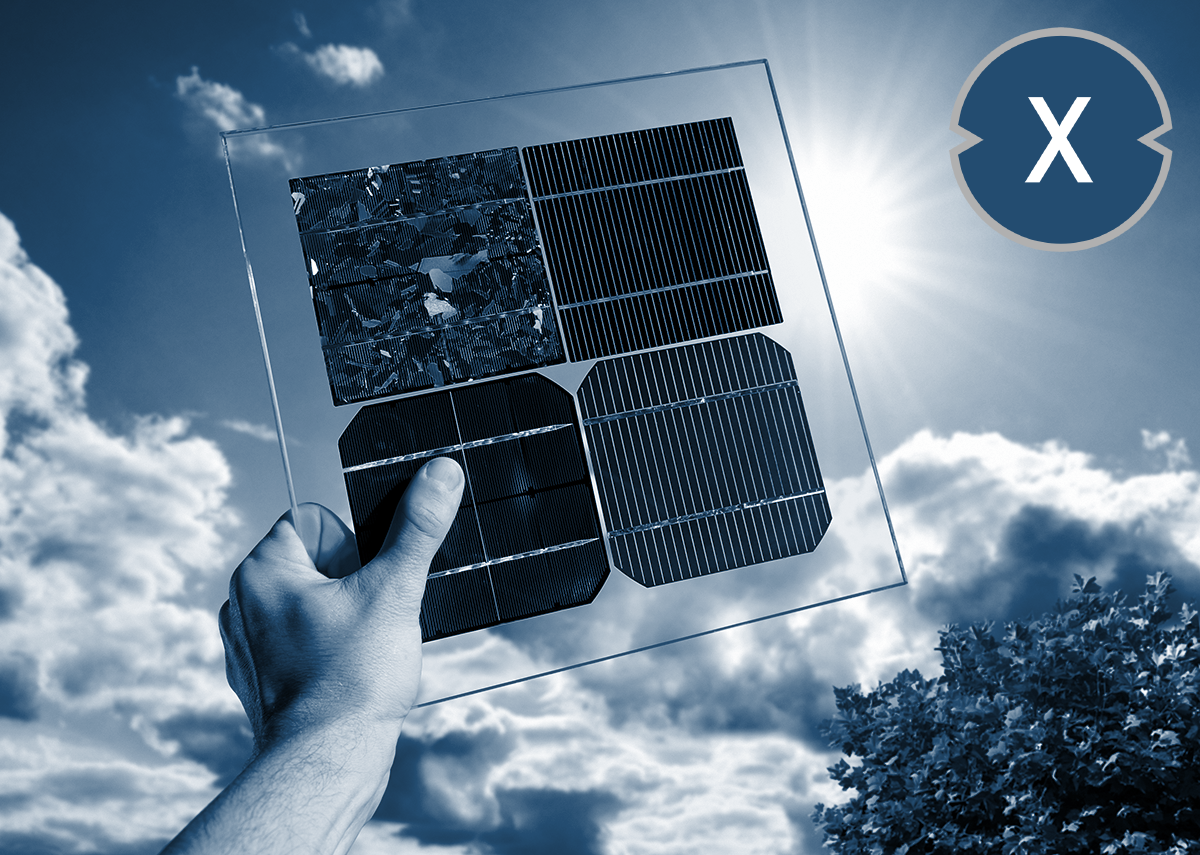
For solar modules: Samples of various polycrystalline and monocrystalline solar cells – Image: Xpert.Digital / Petair|Shutterstock.com
Solar modules: What types are there?
Technological development in solar cells continues to progress rapidly. What was state-of-the-art and innovative yesterday is often outdated tomorrow. Technological advancements make the systems increasingly robust and efficient, leading to rising demand for PV electricity. This demand is likely to be further boosted by the Climate Protection Act and Germany's goal of achieving climate neutrality by 2045, which is why a significant increase in renewable energy is expected in the coming years.
The efficiency of PV technology depends crucially on the different types of solar modules used. In Germany, four module types in particular dominate the use of PV systems. We present their advantages and disadvantages, as well as their future prospects.
Solar modules: What types are there?
The different types of PV modules are characterized by their sometimes significant differences in technical design. This results in widely varying performance, lifespan, and costs. We will examine them in more detail below:
- Glass-glass / double-glazed modules
- Polycrystalline modules
- Monocrystalline modules
- Thin-film modules
- CIS/CIGS modules
Glass-glass / double-glazed modules
In the glass module with bifacial cell technology, light is captured on both the front and back of the module. Increasing the amount of light captured increases the module's efficiency.
Suitable for:
Polycrystalline modules (Notable feature: blue coloration)
Polycrystalline PV modules, like their monocrystalline counterparts, are made from silicon. After the silicon is melted, it is poured into elongated, rectangular molds and slowly cooled. The resulting crystal structures are then separated in further production steps and sliced into wafers, which form the polycrystalline solar cells. Visually, they are distinguished by their striking blue color.
This process has the advantage of being relatively inexpensive, which is why polycrystalline PV modules were among the most widely used solar cells for a long time. The technology has been proven in operation for many years and is therefore extremely reliable. Besides its low susceptibility to malfunctions, a long lifespan is another advantage of this system. However, the manufacturing process has the disadvantage of creating imperfections at the interfaces between the individual crystals. This results in an efficiency of these solar cells that is only average, at 12 to 16%. Consequently, the required space is increased and the efficiency decreases.
Two further disadvantages that polycrystalline and monocrystalline modules have in common are their relatively high weight and performance losses under diffuse light conditions and high temperatures.
Monocrystalline modules (distinctive feature: shimmering dark blue to black)
Monocrystalline modules are also made of silicon. Unlike polycrystalline modules, the silicon is melted a second time, resulting in columnar single crystals (hence "mono"). They do not suffer from the frictional losses observed in polycrystalline modules. This leads to a higher efficiency of up to 20% in these dark blue to black shimmering solar cells.
Besides their low susceptibility to malfunctions and their proven design over decades, monocrystalline modules are characterized by their smaller footprint. However, these modules are comparatively expensive to manufacture. Furthermore, they are relatively heavy and have reduced efficiency under poor lighting conditions and high temperatures.
Conclusion on crystalline solar modules
In summary, both crystalline module types offer effective performance. However, they are relatively heavy, with monocrystalline solar modules being the better choice in confined spaces due to their higher efficiency. Their greater efficiency has led to their widespread adoption over polycrystalline solar cells, despite their higher price.
However, the fact that polycrystalline modules are up to one third cheaper (per kWp) ensures that they continue to be very popular, especially for larger PV systems without space constraints.
Thin-film modules
As the name suggests, thin-film modules are characterized by their extremely low thickness. Traditionally, thin-film modules are manufactured using semiconductors made of amorphous silicon. In this system, a substrate material, usually made of glass, is coated with a thin layer. This construction method results in thin-film solar cells being approximately 100 times thinner than two solar modules made from silicon wafers.
In microelectronics, photovoltaics, and microsystems technology, wafers are circular or square disks approximately one millimeter thick. They are manufactured from monocrystalline or polycrystalline (semiconductor) blanks, known as ingots, and typically serve as substrates (base plates) for electronic components, including integrated circuits (ICs, "chips"), micromechanical components, and photoelectric coatings. In the production of microelectronic components, several wafers are usually combined into a batch and processed either sequentially or in parallel.
This is also one of the greatest advantages of thin-film modules, as their low weight makes them very flexible and versatile. Therefore, these modules are no longer only used in large PV systems, but also for power generation in watches and other small electronic devices. In addition, thin-film modules are easy to manufacture and inexpensive to produce due to their low raw material requirements, which has further boosted their widespread use. Furthermore, their performance curve does not flatten out as much under unfavorable lighting conditions as that of the two crystalline modules mentioned above.
However, these narrow modules have the disadvantage of a significantly lower efficiency than other solar cells. This can be as low as 7%, meaning their use in PV systems requires a considerable amount of space. To achieve higher efficiency, manufacturers have switched to producing thin-film modules with cadmium telluride (CdTe). This design principle offers the advantage of a slightly higher efficiency of up to 8%. It is particularly suitable for use in areas with high levels of haze and fog, as well as in diffuse light. However, users must accept higher prices and additional costs for the more expensive recycling of the cadmium contained in the modules during decommissioning. Despite the increased costs, the use of this more efficient module design is now on the rise.
Furthermore, many companies are currently researching thin-film modules manufactured using copper-zinc-tin sulfide and sulfur (CZTS). This semiconducting material has the advantage over conventional thin-film solar cells that its construction does not require the use of rare and toxic elements. However, it will likely be some time before this technology is ready for mass production.
CIS/CIGS thin-film modules
These modules are a special type of thin-film solar cell and currently the second most common design in this field, after the CdTe variant. They are based on the compounds copper indium diselenide (CIS) or copper indium gallium diselenide (CIGS) and conduct electricity significantly better than silicon-based thin-film modules. Their efficiency ranges between 12 and 15%, which is equivalent to the highest efficiency among thin-film solar cells. They also suffer only minimal losses in diffuse light and high temperatures and are also lightweight and resistant to defects.
These advantages are offset by the expensive manufacturing process and the complex recycling of the selenium contained in the modules. Furthermore, due to the relatively recent development of these modules, there is a lack of long-term data on the system's durability. However, it is primarily the high price that has caused the production of these solar cells to stagnate for years.
📣 Solar modules and photovoltaic solutions (roofs, open spaces such as solar carport systems) for industry, retail and municipalities
Everything from a single source, specially designed for solar solutions for large parking areas. You refinance or counterfinance into the future with your own electricity generation.
🎯 For solar engineers, plumbers, electricians and roofers
Advice and planning including a non-binding cost estimate. We bring you together with strong photovoltaic partners.
👨🏻 👩🏻 👴🏻 👵🏻 For private households
We are positioned across regions in German-speaking countries. We have reliable partners who advise you and implement your wishes.
- Plan photovoltaics for warehouses, commercial halls and industrial halls
- Industrial plant: Plan a photovoltaic open-air system or open-space system
- Plan solar systems with photovoltaic solutions for freight forwarding and contract logistics
- B2B solar systems and photovoltaic solutions & advice
The right solar modules for your project: Xpert.Solar offers planning and consulting services for solar carports, rooftop solar systems, and photovoltaic systems in general. We also support you in finding the right and suitable solar modules!
I would be happy to serve as your personal advisor.
You can contact me by filling out the contact form below or simply call me on +49 89 89 674 804 .
I'm looking forward to our joint project.
Xpert.Digital – Konrad Wolfenstein
Xpert.Digital is a hub for industry with a focus on digitalization, mechanical engineering, logistics/intralogistics and photovoltaics.
With our 360° business development solution, we support well-known companies from new business to after sales.
Market intelligence, smarketing, marketing automation, content development, PR, mail campaigns, personalized social media and lead nurturing are part of our digital tools.
You can find out more at: www.xpert.digital – www.xpert.solar – www.xpert.plus

